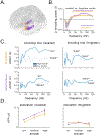Neuronal activity in the human amygdala and hippocampus enhances emotional memory encoding
- PMID: 36646837
- PMCID: PMC11243592
- DOI: 10.1038/s41562-022-01502-8
Neuronal activity in the human amygdala and hippocampus enhances emotional memory encoding
Abstract
Emotional events comprise our strongest and most valuable memories. Here we examined how the brain prioritizes emotional information for storage using direct brain recording and deep brain stimulation. First, 148 participants undergoing intracranial electroencephalographic (iEEG) recording performed an episodic memory task. Participants were most successful at remembering emotionally arousing stimuli. High-frequency activity (HFA), a correlate of neuronal spiking activity, increased in both the hippocampus and the amygdala when participants successfully encoded emotional stimuli. Next, in a subset of participants (N = 19), we show that applying high-frequency electrical stimulation to the hippocampus selectively diminished memory for emotional stimuli and specifically decreased HFA. Finally, we show that individuals with depression (N = 19) also exhibit diminished emotion-mediated memory and HFA. By demonstrating how direct stimulation and symptoms of depression unlink HFA, emotion and memory, we show the causal and translational potential of neural activity in the amygdalohippocampal circuit for prioritizing emotionally arousing memories.
© 2023. The Author(s), under exclusive licence to Springer Nature Limited.
Conflict of interest statement
Declaration of Interests
The authors declare no competing interests.
Figures




References
-
- Bradley MM, Greenwald MK, Petry MC & Lang PJ Remembering pictures: pleasure and arousal in memory. Journal of Experimental Psychology: Learning, Memory, and Cognition 18, 379 (1992). - PubMed
-
- Kensinger EA & Corkin S Memory enhancement for emotional words: are emotional words more vividly remembered than neutral words? Mem Cognit 31, 1169–80 (2003). - PubMed
-
- Reisberg D & Hertel P Memory and emotion (Oxford University Press, Oxford, 2004). URL http://www.loc.gov/catdir/toc/ecip041/2003006595.html.
-
- Klüver H & Bucy PC Preliminary analysis of functions of the temporal lobes in monkeys. J Neuropsychiatry Clin Neurosci 9, 606–20 (1939). - PubMed
Publication types
MeSH terms
Grants and funding
LinkOut - more resources
Full Text Sources

